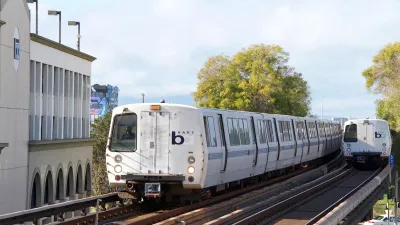Ryan Holeywell discusses a new report from researchers at the University of California, Berkeley that examines the top reasons people stop using public transit. Frequent, consistent service is most important to riders.
Findings presented this week at the Transportation Research Board's annual conference in Washington, D.C. may provide guidance for transit agencies trying to balance increases in ridership with strained budgetary environments. "While it's well-known that reliability is important to riders," says Holeywell, "it's less understood how, exactly, common transit problems impact the public's likelihood to reduce their ridership in the long-term."
So, in surveying public transit riders in the San Francisco area, the Berkeley researchers sought to dig deeper into the causes of "unreliability", and how they effect the mindset of riders.
"Frequent, consistent service -- and in particular, reliable transfers between stops -- are what's most important to riders, according to the study. Riders care most about getting picked up from their stop in 10 minutes or less, and they especially value being able to make their scheduled connections. They're not so interested in whether their rides are crowded or whether they can find a seat."
"But a few key things in particular irk passengers: delays that occur once they board a vehicle and delays when they're trying to make a transfer. Delays at transfer stops were more than twice as likely to make someone reduce their transit use than a delay at the point of origin. Riders were especially turned off by delays due to operational problems like backups in the system."
"At a time when transit agencies continue to take budgetary hurdles," concludes Holeywell, "the insights from the study are worth considering. Since certain failings have much larger impacts on ridership than others, it may be in public transportation agencies' best interest to focus resources on minimizing those inconveniences in particular."
FULL STORY: Top Reasons People Stop Using Public Transit

Manufactured Crisis: Losing the Nation’s Largest Source of Unsubsidized Affordable Housing
Manufactured housing communities have long been an affordable housing option for millions of people living in the U.S., but that affordability is disappearing rapidly. How did we get here?

Americans May Be Stuck — But Why?
Americans are moving a lot less than they once did, and that is a problem. While Yoni Applebaum, in his highly-publicized article Stuck, gets the reasons badly wrong, it's still important to ask: why are we moving so much less than before?

Using Old Oil and Gas Wells for Green Energy Storage
Penn State researchers have found that repurposing abandoned oil and gas wells for geothermal-assisted compressed-air energy storage can boost efficiency, reduce environmental risks, and support clean energy and job transitions.

Updating LA’s Tree Rules Could Bring More Shade to Underserved Neighborhoods
A new USC study finds that relaxing Los Angeles’ outdated tree planting guidelines could significantly expand urban tree canopy and reduce shade disparities in lower-income neighborhoods, though infrastructure investments are also needed.

California's Canal Solar Projects Aim to Conserve Resources and Expand Clean Energy
California’s Project Nexus has begun generating electricity from solar panels installed over irrigation canals, with researchers and state agencies exploring statewide expansion to conserve water and boost clean energy production.

HHS Staff Cuts Gut Energy Assistance Program
The full staff of a federal program that distributes heating and cooling assistance for low-income families was laid off, jeopardizing the program’s operations.
Urban Design for Planners 1: Software Tools
This six-course series explores essential urban design concepts using open source software and equips planners with the tools they need to participate fully in the urban design process.
Planning for Universal Design
Learn the tools for implementing Universal Design in planning regulations.
Heyer Gruel & Associates PA
City of Moreno Valley
Institute for Housing and Urban Development Studies (IHS)
City of Grandview
Harvard GSD Executive Education
Salt Lake City
NYU Wagner Graduate School of Public Service
City of Cambridge, Maryland




























